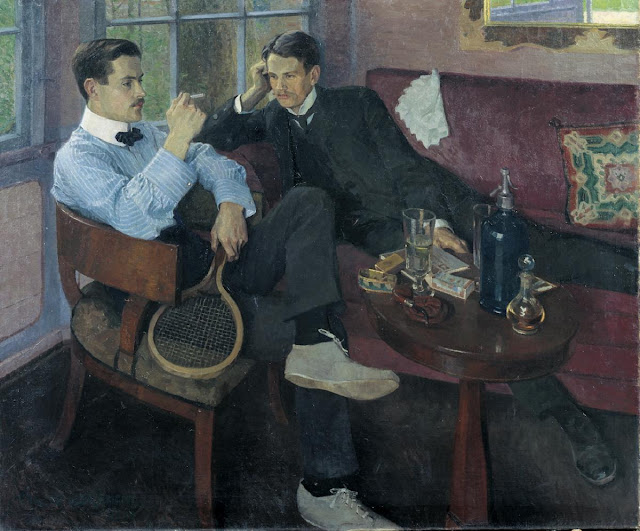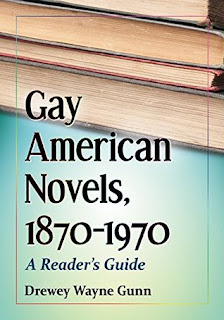 |
| Aubrey Beardsley (1895) Jacques-Emile Blanche (French, 1861-1942) Oil on canvas 36.5 x 29 in. (92.6 x 73.7 cm.) © National Portrait Gallery, London |
Tuesday, December 21, 2021
Aubrey Beardsley by Jacques-Emile Blanche
Wednesday, December 8, 2021
The Confessions of Aubrey Beardsley by Donald S. Olson
 |
| London : Bantam Press, 1993 |
Wednesday, November 10, 2021
Krijgsmanen (Warriors) by Jean-Eugène-Charles Alberti
 |
| Krijgsman met getrokken zwaard = Warrior with Drawn Sword (1808) Jean-Eugène-Charles Alberti (Dutch, 1777-1843) Oil on canvas 92.5 x 73 cm Rijksmuseum Amsterdam |
 |
| Krijgsman met lans en schild = Warrior with Lance and Shield (1808) Jean-Eugène-Charles Alberti (Dutch, 1777-1843) Oil on canvas 91.5 x 72.5 cm Rijksmuseum Amsterdam |
Tuesday, November 2, 2021
The Great Mistake by Jonathan Lee
 |
| New York : Knopf, 2021 |
Sunday, October 24, 2021
Die Quelle by Ludwig von Hofmann
 |
| Die Quelle (1913) Ludwig von Hofmann (German, 1861-1945) Thomas Mann Archives, Eidgenössische Technische Hochschule Zürich Public domain via Wikimedia Commons Hung in Thomas Mann's study and traveled with him to Switzerland, the United States and back again during his years of exile from Germany. |
Friday, October 22, 2021
The Magician by Colm Toibin
 |
| New York : Scribner, 2021 |
Tuesday, August 31, 2021
Monday, August 23, 2021
Alec by William di Canzio
 |
| New York: Farrar, Straus & Giroux, 2021 |
Wednesday, July 21, 2021
Hemdanziehender Knabe = Boy Putting on Shirt by Helmut Kolle
 |
| Hemdanziehender Knabe = Boy Putting on Shirt (1924) Helmut Kolle (German, 1899-1931) Oil on canvas 92 x 65 cm. |
Tuesday, July 6, 2021
Romance in Marseille by Claude McKay
 |
| New York : Penguin, 2020 |
Friday, June 25, 2021
Gassed by John Singer Sargent
 |
| Gassed (1919) John Singer Sargent (American, 1856-1925) Oil on Canvas 90½ x 240 in. Imperial War Museums, London |
Monday, June 21, 2021
Queers: Eight Monologues curated by Mark Gatiss
 |
| London : Nick Hern Books, 2017 |
The Man on the Platform
The Perfect Gentleman
Safest Spot in Town
Missing Alice
I Miss the War
More Anger
A Grand Day Out
Something Borrowed
Queers | BBC America
Wednesday, May 19, 2021
Junglinge im Gartenpavillion by Friedrich Ahlers-Hestermann
Tuesday, May 4, 2021
Maurice by E. M. Forster
 |
| New York : W. W. Norton, 1971 |
 |
| Abinger Edition : 5 London : André Deutsch, 1999 |
Wednesday, April 21, 2021
Murder by Jared French
 |
| Murder (1942) Jared French (American, 1905-1988) Egg tempera on plaster coated panel 43.18 x 36.83 cm The Pennsylvania Academy of the Fine Arts |
Tuesday, April 6, 2021
The End of My Life by Vance Bourjaily
 |
| New York : Scribner's, 1947 |
Thursday, March 25, 2021
Rough Trade by Arthur Lett-Haines
Tuesday, March 9, 2021
Sojourn Among Shadows by Murrell Edmunds
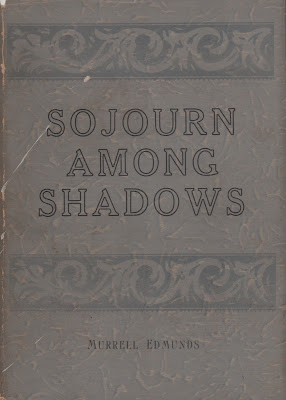 |
| Caldwell, ID : Caxton, 1936 |
Thursday, February 18, 2021
Saturday, February 6, 2021
Bibliographies of Gay Literature II
In 2014, I posted about a handful of early 20th century bibliographies of gay literature, covering novels, short stories, plays and in some cases biography and biographical fiction. Those publications not only tried to provide a list of titles but also described them through various ratings systems to declare the extent of the gay content and/or the nature of the content. A number of other bibliographies that are more descriptive in nature, and focus exclusively on the novel have also been published and are presented here. A single work focused entirely on plays has also been included as it can be thought of as the third part in a mammoth undertaking covering British Commonwealth and American novels and plays by Drewey Wayne Gunn. This batch of bibliographies focus more on thumbnail sketches, and in some cases more lengthy analysis, of the storyline as opposed to boiling things down to a single rating. Using resources from both groups of bibliographies together can provide a more complete picture of an individual novel or play.
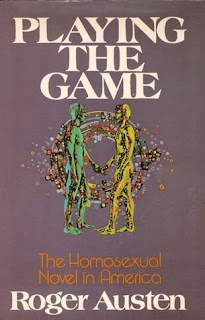 |
| Indianapolis : Bobbs-Merrill, 1977 |
Austen, Roger
Indianapolis : Bobbs-Merrill, 1977
 |
| New York : Garland, 1991 |
Levin, James
New York: Garland Publishing, 1991
Structurally, Levin's The Gay Novel in America owes much to Austen's 1977 work. Also structured into prose chapters covering segments of literary history, but more fully fleshing out the earliest literature, Levin also pushes forward to the 1980s.
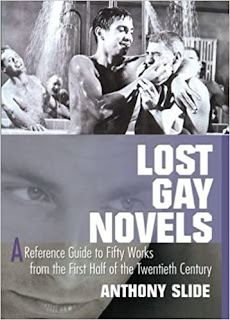 |
| New York : Harrington Park Press, 2003 |
 |
| Jefferson, NC : McFarland, 2014 |
Thursday, January 28, 2021
The East Window by Edward Brian Seago
 |
| The East Window (1944) Edward Brian Seago (English, 1910-1974) Oil on hardboard 48.8 x 37 cm Norfolk Museums Service |
Wednesday, January 13, 2021
The Charioteer by Mary Renault
 |
| New York : Pantheon, 1959 |
"After some years of muddled thinking on the subject, he suddenly saw quite clearly what it was he had been running away from; why he had refused Sandy's first invitation, and what the trouble had been with Charles. It was also the trouble, he perceived, with nine-tenths of the people here tonight. They were specialists. They had not merely accepted their limitations, as Laurie was ready to accept his, loyal to his humanity if not to his sex, and bringing an extra humility to the hard study of human experience. They had identified themselves with their limitations; they were making a career of them. they had turned from all other reality, and curled up in them snugly, as in a womb." (p.132)
Later when Laurie contemplates how to live in this gay world, he identifies a break we still too often see today between effeminate gay men and those who pass.
"There was a man at Oxford. ... He kept telling me I was queer, and I'd never heard it called that before and didn't like it. The word, I mean. Shutting you away, somehow; roping you off with a lot of people you don't feel much in common with, half of whom hate the other half anyway, and just keep together so that they can lean up against each other for support." (p.152-3)
Renault has offered up a compelling coming of age novel which frankly addresses the realities and difficulties of forging a life as a gay man in England in the 1940s.
Bibliographies & Ratings: Cory (IV); Garde (P, 117***); Mattachine Review (IV); Young (3259*)

